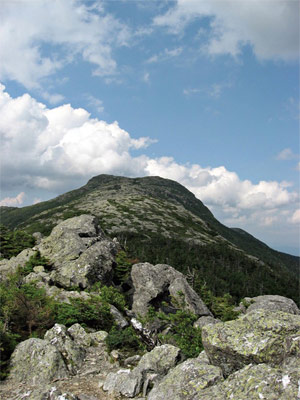
Photo by Thomas Jones
Treeline in the East is lower than out West
Treeline in the East is lower than out West
Trees grow where they can. And they are surpassingly capable, making do in an impressive array of conditions around the globe, including many harsh places. But there are limits to their versatility. There are some natural environments where trees simply do not grow, thrive, or even survive, such as near the tops of the bigger mountains.
As you hike up a big one, you can see many gradual changes in the composition of the forest. Eventually the diversity of species plummets, the trees are much shorter and more scattered, and at last they look more like shrubs. Then, at some elevational limit (in any mountain locale), the trees stop. Fact is, most don’t even start. Above here, even if a Bicknell’s thrush dropped a viable mountain ash seed, it would have a slim chance of survival, much less germination. This is the alpine elevational treeline, although it is very rarely a distinct line.
Treeline is more commonly an uneven zone of transition from scattered shrubby trees to treeless areas with but a few specialized – and very tough – herbs and a hardy crust of lichens. The transition occurs unevenly because there may be sheltered and sunnier local conditions – various crevices, coves, and crannies – at higher elevations where trees can still make it, thus extending the upper limit of the forest here and there. Indeed, topography, soils, precipitation, and exposure to sun, wind, snow, and ice all play important roles in determining which trees grow where and how well. But temperature generally decreases with increasing elevation (and latitude), and many ecologists suggest that low temperatures – which limit growth in general – seem to be the single most critical factor in determining the upper elevational (and latitudinal) limit of trees.
Alpine (and arctic) environments are marked by seriously harsh winters. And while trees there do take a beating that severely limits their growth, some species have made amazing adaptations to withstand such winters. But to do so, they need a sufficiently long summer growing season – free of snow on the ground and with adequate temperatures – to earn a living that they spend all winter long. The problem at higher elevations (and latitudes) is that the growing season is not only colder but also shorter. It starts later at higher elevations because spring bud break is so closely tied to the temperature of the soil, which takes longer there to warm up.
The elevational limit of such suitable summer conditions varies by latitude. In Mexico, for example, treeline occurs somewhere around 13,000 feet, whereas farther north, in the Tetons, for instance, it occurs lower, at approximately 10,000 feet. Again, it’s a ragged line that may vary by hundreds of feet on any mountain, depending largely on shelter and exposure.
But how then to explain the elevation of treeline in the White Mountains of New Hampshire? Mount Washington sits at a latitude comparable to the Tetons, but its treeline is at roughly 4,500 feet. That’s less than half the elevation. Is it because the Presidential Range has frighteningly bad winters that blast needles right off trees with screaming bits
But how then to explain the elevation of treeline in the White Mountains of New Hampshire? Mount Washington sits at a latitude comparable to the Tetons, but its treeline is at roughly 4,500 feet. That’s less than half the elevation. Is it because the Presidential Range has frighteningly bad winters that blast needles right off trees with screaming bits
of ice? Sure, wind plays a part in limiting tree growth, by desiccating needles, scouring away thin soils, and directly damaging limbs and twigs. But winter is brutally hard in the Tetons, too, and nearly as windy.
The difference, instead, may have more to do with summer conditions, when trees have their only chance to germinate, grow, and reproduce. Because the Tetons are inland – and are so much more massive – their summers are warmer and drier than in the White Mountains, which are closer to the coast and therefore have cooler and cloudier summers. On Mt. Washington, in fact, there has never been a temperature recorded higher than 70 degrees.
Because the elevational treeline is so closely tied to temperature, many suggest that it could be a particularly sensitive indicator of global climate change. Presumably, rising temperatures would increase the elevation of treeline in any locale, altering forest distribution and potentially ousting rare plant communities – and their inhabitants – that now exist above treeline. Although the specific physiological mechanism of treeline formation is not fully understood, there is growing photographic and other evidence of upward shifts in treelines worldwide.
The difference, instead, may have more to do with summer conditions, when trees have their only chance to germinate, grow, and reproduce. Because the Tetons are inland – and are so much more massive – their summers are warmer and drier than in the White Mountains, which are closer to the coast and therefore have cooler and cloudier summers. On Mt. Washington, in fact, there has never been a temperature recorded higher than 70 degrees.
Because the elevational treeline is so closely tied to temperature, many suggest that it could be a particularly sensitive indicator of global climate change. Presumably, rising temperatures would increase the elevation of treeline in any locale, altering forest distribution and potentially ousting rare plant communities – and their inhabitants – that now exist above treeline. Although the specific physiological mechanism of treeline formation is not fully understood, there is growing photographic and other evidence of upward shifts in treelines worldwide.
---------------------------------------------------------------------------------
Michael Snyder is the Chittenden (Vermont) County Forester.














No comments:
Post a Comment